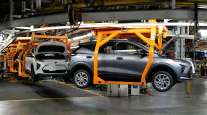Fleets Urge Standards Over Technologies With Next Federal Greenhouse-Gas Rule
This story appears in the May 5 print edition of Transport Topics.
WASHINGTON — Fleet executives told a National Research Council committee of their efforts to save on fuel consumption and what they would recommend to federal agencies that are writing the next rule on greenhouse-gas emissions.
The for-hire and private fleet managers said regulators must understand the wide range of trucks in operation and how the vehicles are used. Therefore, they said, it would be best to set numerical standards for truck makers to hit rather than order the inclusion of specific technologies on trucks.
Fleet opinion was central to the committee’s 10th and final session for collecting data on how to write Phase 2 of the federal greenhouse-gas rule likely to take effect in 2020.
President Obama said earlier this year that he wants the Environmental Protection Agency and the National Highway Traffic Safety Administration to join in writing a second rule on carbon dioxide emissions and mileage standards for heavy- and medium-duty trucks.
The first rule from EPA and NHTSA was published in 2011. Its effective dates were split between January of this year and January 2017. NRC was asked to study the issue and make recommendations to the two agencies.
FedEx Express was one of the five carriers presenting before the NRC committee, and Tom Griffin, chief engineer of global vehicles, said the company has been working seriously on cutting fuel spending since 2005.
“We’ve saved 89 million gallons of fuel since then,” Griffin told the team of researchers from universities and industry. A division of FedEx Corp., Express has 90,000 ground vehicles that it uses in conjunction with its fleet of cargo aircraft.
Buying smaller medium-duty pickup-and-delivery vehicles has been an important thrust, he said. Keeping vehicles with extra horsepower that’s rarely used is now considered a waste.
“We’ve been trying to right-size our vehicles,” Griffin said.
Mike O’Connell, who runs fleet operations for Frito-Lay, a division of PepsiCo, said perhaps his main task is to match the right truck to the job at hand.
“It’s all about duty cycles,” said O’Connell, who agreed with Griffin on sizing vehicles correctly.
“We had too much engine power,” O’Connell said of his fleet several years ago. Frito-Lay began its fuel-efficiency campaign in earnest in 2008, when the economy was falling into recession.
On the heavy-duty side, the company uses a lot of compressed natural gas, O’Connell said. Of the 1,200 tractors in his fleet, 220 use CNG.
Payback on the investment is not difficult for the chip maker, he said, because the company keeps tractors for at least seven years.
“If you keep them for three years and then flip them, it won’t work,” he said.
Frito-Lay has been signing deals with CNG fueling chains to get fuel. O’Connell said he has offered to become an “anchor tenant,” and fuel sellers have jumped at the chance to have Frito-Lay dedicate a large portion of its purchases to them.
While CNG works well for many of his Class 8s, the fuel is not an option on the medium-duty side. Considering the miles per gallon he gets on midrange diesel engines and the modest number of miles per year the vehicles run, CNG does not fit into delivery work, O’Connell said.
Con-way Inc. has found CNG more challenging, Vice President Randal Mullett said. The company, a provider of less-than- truckload and truckload services, has purchased CNG-powered tractors with expanded tank capacity for longer range.
Mullett said a diesel-burning tractor costs the company $103,000, but CNG-fueled models are $198,000 each. They do save Con-way 10 cents a mile, but maintenance costs are higher.
“The numbers don’t work now, but I think this probably will happen at some point,” he added.
Mullett told the committee there usually are competing goals on how to buy trucking equipment. He said the company could buy lighter, more fuel-efficient trailers, but Con-way managers prefer sturdier, heavier units that last longer and provide more security for customers’ freight.
The company tried 6x2 power configurations for tractors, which are lighter and save on fuel. However, they do not work well in cold weather, Mullett said, so drivers refused to use them, and the company went back to a traditional 6x4 arrangement.
Con-way’s trucks burn about 150 million gallons of fuel a year, so the company has a major incentive to save, Mullett said. Management paid Princeton University mathematicians and computer scientists to re-
engineer Con-way’s LTL linehaul network, and that sliced annual driving by 16.6 million miles a year.




